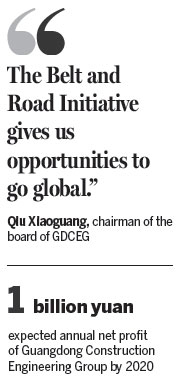Guangdong Construction to step up overseas play
Guangdong Construction Engineering Group Co Ltd, a State-owned industry leader based in Guangzhou, plans to expand its overseas business by increasing investments and strengthening R&D.
Toward this end and other purposes, GDCEG has co-launched a series of investment platforms with banks as well as governmental and nongovernmental funds.
These platforms can draw investments worth more than 50 billion yuan ($7.35 billion), said Qiu Xiaoguang, chairman of the board of GDCEG.
The platforms are expected to help the SOE increase its overseas investments, which are very limited now.
Overseas business takes only about 10 percent of the total volume, with projects in Laos, Cambodia, Myanmar and the Middle East.
For example, it built the first thoroughfare in Vientiane, the capital and largest city of Laos, and has a plan to invest in a power station in Laos.
"The Belt and Road Initiative gives us opportunities to go global. We are carefully increasing our investments overseas, especially in Southeast Asia," said Qiu.

With the help of the planned investment platforms, GDCEG will be able to participate in more and bigger domestic public-private-partnership projects as well, Qiu said.
For instance, it is working with the city government of Meizhou in Guangdong province on an 8-billion-yuan project to rebuild shanties.
GDCEG is also guiding its two major subsidiaries toward big projects, including some stationed abroad.
To take advantage of city rails' rapid development, China Tunnel Construction (Guangdong), one of its subsidiaries, is going to build a production base capable of making 50 sets of tunnel-boring machines for the markets in South China and in Southeast Asia, according to Zhao Hui, the company's president.
In 2013, China Tunnel Construction invented China's first tunnel-boring machine that can use both earth pressure and slurry to excavate tunnels.
There are two sets of such machines and they have proved their safety and efficiency in the construction of subway lines 9 and 21 of Guangzhou, which were deemed the city's two most difficult subway lines to build because of the complicated landforms they run through.
China's city rail transportation is on a fast track of development. By September, the National Development and Reform Commission had approved the plan of building railway systems in 43 cities that have a total track length of about 8,600 km.
Guangdong Provincial Academy of Building Research Group, the other major subsidiary of GDCEG, owns the country's biggest wind tunnel laboratory, which conducted the important wind tunnel testing for the Canton Tower in Guangzhou and the Sultan Ibrahim Larkin Stadium in Malaysia.
The research company is building a four-times-bigger wind tunnel laboratory in Guangdong province, which will enable the company to take larger projects such as testing for huge bridges, according to Qiu.
Founded in 1953, GDCEG is the main builder of office buildings, water conservancy projects, rail traffic facilities, roads and bridges as well as architectural icons in South China.
Its profit from January to October was 370 million yuan, up 44 percent year-on-year. It plans to boost its annual net profit to more than 1 billion yuan by 2020 and annual revenue to more than 50 billion yuan.
To achieve this goal, the SOE is upgrading and transforming itself from a builder to a provider of comprehensive services for city development, covering every link in the industry chain - planning and design, scientific research, building, investing and fundraising, and operations management.
xujingxi@chinadaily.com.cn
(China Daily 12/13/2016 page16)



 Print
Print Mail
Mail

